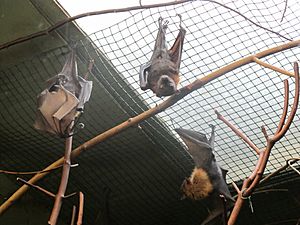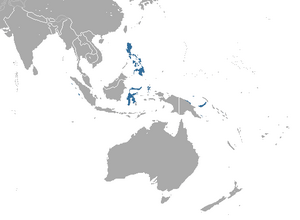Small flying fox facts for kids
Quick facts for kids Small flying fox |
|
|---|---|
 |
|
| Conservation status | |
| Scientific classification | |
| Genus: |
Pteropus
|
| Species: |
hypomelanus
|
 |
|
| Small flying fox range | |
The small flying fox is also called the island flying fox or variable flying fox. Its scientific name is Pteropus hypomelanus. This amazing animal is a type of flying fox from the Pteropodidae family. You can find these bats in many countries. They live in places like Australia, Cambodia, Indonesia, Malaysia, the Maldives, Myanmar, Papua New Guinea, the Philippines, the Solomon Islands, Thailand, and Vietnam.
Contents
What Does the Small Flying Fox Look Like?
The small flying fox can look quite different from one bat to another. Its head is usually dark brown. Sometimes it can be yellowish-brown. Bats living in the eastern parts of their home range often have paler heads.
Their back is a brownish-orange color. Their belly and chest are usually a light yellowish-brown. Their ears have some fur on them. The parts of their wings that help them fly are black. This bat has short fur on its back. The fur on its belly is a bit longer.
You can tell this bat apart from the Ryukyu flying fox. The small flying fox has bare legs (tibia). The Ryukyu flying fox has fur on its legs.
Where Do Small Flying Foxes Live?
The small flying fox lives on islands in the Indo-Pacific region. This area includes the Maldives, the Andaman Islands, the Nicobar Islands, Melanesia, the Philippines, Indonesia, Papua New Guinea, and the Solomon Islands.
They can live in places up to about 900 meters (about 3,000 feet) high. In many areas, these bats sleep during the day on small islands. At night, they fly to bigger islands to find food.
Life and Habits of the Small Flying Fox
Small flying foxes are mostly fruit eaters. They also enjoy flowers and nectar.
What Do Small Flying Foxes Eat?
Their diet includes many different fruits. They eat pawpaws, mangos, jambul fruit, bananas, and figs. They also eat flowers from trees like the kapok tree and the banyan. Sometimes they eat flowers and fruits from farm crops. These bats eat about half their own body weight every day! That's like a human eating half their weight in food!
Reproduction and Life Cycle
These bats can start having babies when they are about one year old. The time of year they breed changes depending on where they live. A baby bat grows inside its mother for about 200 days.
Usually, a mother bat gives birth to one baby, called a pup. The pup drinks its mother's milk for about six weeks. But it stays with its mother and depends on her for about four more months.
It's very rare for these bats to have twins. Twins have only been seen twice. Once was in 2009 and again in 2017. Both sets of twins were born at a special bat center in Gainesville, Florida.
Who Hunts the Small Flying Fox?
The white-bellied sea eagle is known to hunt small flying foxes. These eagles catch the bats and drop them into the sea many times. This helps them to catch and eat the bats.
Status of the Small Flying Fox
The IUCN says the small flying fox is "Near Threatened". This means they are not in immediate danger of disappearing. They live in a wide area and there are usually many of them.
However, in some places, they face problems. Losing their forest homes (deforestation) is a threat. Activities related to tourism can also bother them. In the Philippines and other places, people hunt them for food. Farmers also see them as pests because they eat their crops.
See also
 In Spanish: Pteropus hypomelanus para niños
In Spanish: Pteropus hypomelanus para niños


